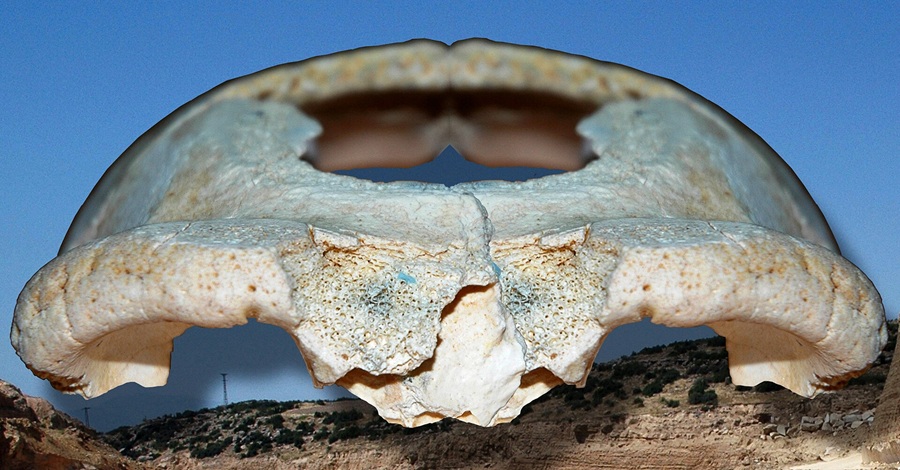- Science
- 23 de October de 2025
- No Comment
- 6 minutes read
The mind of Homo Erectus

Skull of Kocabaş. / Photo: Wikimedia. Author:
Homo erectus marked a clear before-and-after in human evolution. The reason lies in the species’ revolutionary cognitive capacity, which greatly enhanced inventiveness among our ancestors. Throughout its evolution, H. erectus refined its techniques and strategies for resource management. Evidence of this is found in the emergence of new lithic technologies, specifically the bifacial tools of Mode II, which appeared between 2 and 1.6 million years ago.
But their ingenuity did not stop there: H. erectus established stable hearths over a million years ago. Sites such as Koobi Fora in East Africa and Swartkrans in South Africa—dating to roughly 1.6 million years ago, about one-third into the species’ existence—attest to this. A diet increasingly rich in meat, coupled with the controlled use of fire for cooking, allowed for softer foods, opening up new adaptive pathways while chimpanzees and bonobos were diversifying across Africa.
The social life of H. erectus and their capacity to plan resource acquisition hint at a fundamentally social mind. Had they evolved towards greater individualism, they would have faced predation by large felids and intense competition with hyenas. For millennia, Homo and these carnivores contended over meat and marrow. H. erectus, however, evolved towards group cohesion and cooperation, mitigating extreme competition with other predators. Supporting evidence comes from the expansion in the neocortex, a region directly involved in individual recognition, which coincided with a larger brain and roughly double the encephalisation of earlier apes. Such a brain demanded far more calories than that of their ancestors: modern humans consume 20–25% of their daily intake via the brain—over twice that of most extant primates. Estimates for H. erectus suggest brain consumption exceeding 17%, compared with 9–11% for Australopithecus, similar to present-day chimpanzees.
Thus, the brain of H. erectus became an energetically costly tissue, making a protein-rich diet almost mandatory. Encephalisation drove dietary shifts towards carnivory rather than the reverse. To support this, H. erectus increasingly relied on lithics to extract marrow and flesh from bones. Other lines of evidence indicate their high carnivory: African specimen KNM-ER 1808 shows marked skeletal deformations linked to liver overconsumption, and excavated sites reveal abundant faunal remains. By 1.95 million years ago, H. erectus was consuming substantial amounts of protein from local fauna, including crocodiles, fish, and turtles. Perhaps this could inspire a tongue-in-cheek advertising campaign by ranchers against vegetarians, claiming, “The East and West weren’t conquered with vegetables”, yet I suspect such paleontological ironies about Homo erectus would not find wide appreciation among Homo sapiens.
Despite their encephalisation and sociality, H. erectus had not yet achieved the defining trait of Homo sapiens: articulated speech. Vertebral canal openings were too narrow to allow the passage of broad nerves regulating the diaphragm, crucial for speech. Consequently, articulate language and the abstract thought of modern humans were still beyond H. erectus.
One neural feature, however, was shared with H. sapiens: the obstetric canal of females. With neonates’ large brains, birth was constrained by pelvic width. Evolution solved this—either the species adapted or faced extinction. If we are reading these pages today, it is because the first option prevailed. The solution was linked to human neoteny, as we have discussed previously. Given that the infants possessed such large brains, there was only one way for them to be born: prematurely. It appears that, from Homo erectus onwards, offspring were delivered before full development in order to pass through the birth canal. By being born so immature, they were less independent than the infants of modern chimpanzees and gorillas. In other words, the learning period in Homo was extended compared with our relatives, which in turn reinforced the development of social structures necessary to support it.
Taken together, H. erectus initiated a snowball effect that amplified encephalisation and cultural sophistication. A more carnivorous diet nourished the brain, a key organ for social cohesion and lithic production, which in turn optimized resource acquisition, supporting continued carnivory. Softer diets contributed to mandibular reduction, allowing cranial expansion.
Biological structures balance one another during development; thus, a smaller mandibular mass allowed greater expansion of the parietal and occipital regions. In other words, this facilitated mandibular reduction at the expense of increased cranial expansion. Evidence from these developmental trade-offs is that Homo erectus significantly increased cranial capacity over the course of its evolution, rising from an initial 800 cc to over 1,300 cc by the end of its existence.
Source: educational EVIDENCE
Rights: Creative Commons


